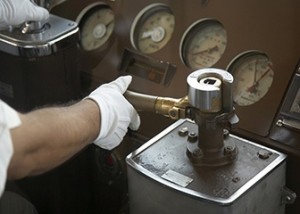Energy Efficiency Jobs
Transportation vehicle, equipment and systems inspectors help control smog and hazardous materials from impacting the environment.
Transportation vehicle, equipment and systems inspectors help control smog and hazardous materials from impacting the environment.
Transportation vehicle, equipment and systems inspectors’ primary focus is to inspect transportation vehicles, equipment, or systems to detect misuse, wear, damage, or mechanical malfunction. These green job holders also inspect vehicles or equipment to ensure that rules, standards, or regulations are complied with. Transportation vehicle, equipment and systems inspectors use diagnostic equipment to perform vehicle or transportation equipment tests. They also inspect repair work done to transportation vehicles or equipment to ensure that repairs were completed properly.
 Emission inspection is an important part of the job of transportation vehicle, equipment and systems inspectors to ensure that vehicles are not releasing harmful smog to the environment. To perform emission inspection, they use onboard diagnostics (OBD) scanner cables and compare emissions findings with applicable emissions standard. An alternative method they also use is to perform low-pressure fuel evaluative tests (LPFET) to check for harmful emissions from vehicles without using onboard diagnostics equipment. Transportation vehicle, equipment and systems inspectors conduct visual inspections of emission control equipment and smoke emitted from gasoline or diesel vehicles. They identify emissions testing procedures and standards appropriate for the age and technology of vehicles. They also identify modifications to engines, fuel systems, emissions control equipment, or other vehicle systems to determine the impact of modifications on inspection procedures.
Emission inspection is an important part of the job of transportation vehicle, equipment and systems inspectors to ensure that vehicles are not releasing harmful smog to the environment. To perform emission inspection, they use onboard diagnostics (OBD) scanner cables and compare emissions findings with applicable emissions standard. An alternative method they also use is to perform low-pressure fuel evaluative tests (LPFET) to check for harmful emissions from vehicles without using onboard diagnostics equipment. Transportation vehicle, equipment and systems inspectors conduct visual inspections of emission control equipment and smoke emitted from gasoline or diesel vehicles. They identify emissions testing procedures and standards appropriate for the age and technology of vehicles. They also identify modifications to engines, fuel systems, emissions control equipment, or other vehicle systems to determine the impact of modifications on inspection procedures.
Ensuring safety and safety procedures is another important aspect of the job of transportation vehicle, equipment and systems inspectors. They evaluate new methods of packaging, testing, shipping, or transporting hazardous materials to ensure sufficient public safety protection and ensure that hazardous materials are not being released to the environment. They examine carrier operating rules, employee qualification guidelines, or carrier training and testing programs for compliance with regulations or safety standards. Transportation vehicle, equipment and systems inspectors also investigate complaints regarding safety violations and make recommendations on carrier requests for waiver of federal standards and. They investigate incidents or violations, such as delays, accidents, and equipment failures. They issue notices and recommend corrective actions when violations or problems are found.
As part of their job, transportation vehicle, equipment and systems inspectors monitor or review output from systems, such as Thermal Imaging Units (TIU) or roadside imaging tools, to identify high risk commercial motor vehicles for follow-up inspections. They negotiate with authorities, such as local government officials, to eliminate hazards along transportation routes. They prepare reports on investigations or inspections and actions taken. They review commercial vehicle logs, shipping papers, or driver and equipment records to detect any problems or to ensure compliance with regulations.
Transportation vehicle, equipment and systems inspectors work both outdoor and indoor in repair shops. They often lift heavy parts and tools, handle greasy and dirty equipment, and stand or lie in awkward positions. They often have to travel to worksites and spent considerable amount of time outdoor. Most transportation vehicle, equipment and systems inspectors work full time. Some work evenings and weekends. Overtime is common in this job.
Transportation vehicle, equipment and systems inspectors usually enter this green career with training in vocational schools, related on-the-job experience or an associate’s degree. Previous work-related skill, knowledge, or experience is required for this job. There is one recognized apprenticeable specialty associated with this occupation: Inspector, Motor Vehicles. Employees in this job typically require one or two years of training with other experienced workers as part of their on-the-job experience. This job usually involves using communication and organizational skills to coordinate, supervise, manage, or train others.
The Bureau of Labor Statistics (BLS) expects employment of this field to grow between 10 to 19 percent from 2010 until 2020; about as fast as the average for all green jobs. The BLS projected 10,700 transportation vehicle, equipment and systems inspectors job openings between 2010 and 2020, and noted 27,000 jobs are currently filled. Titles included Chief Mechanical Officer (CMO), Transit Vehicle Inspector, Smog Technician, Inspector, Motor Carrier Inspector, Quality Assurance Inspector, Rail Technician, Smog Check Technician, Diesel Engine Inspector, and Emission Inspection Technician. The BLS further reports that the median annual wage for salaried transportation vehicle, equipment and systems inspectors was $62,230 in 2011 with median hourly wage of $29.92.